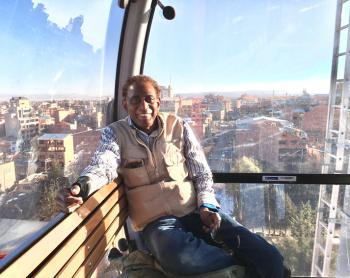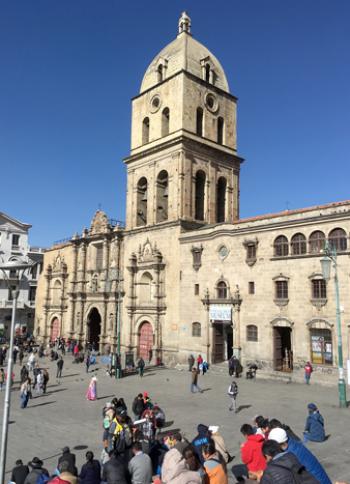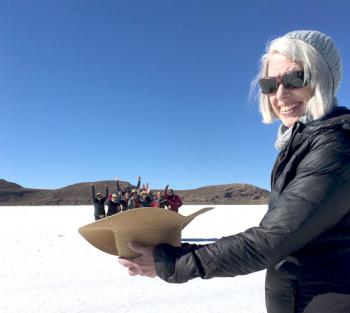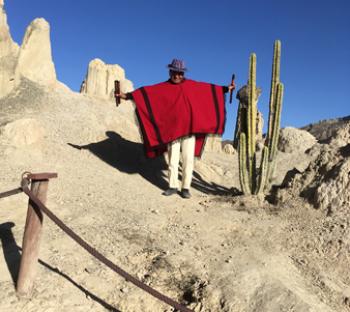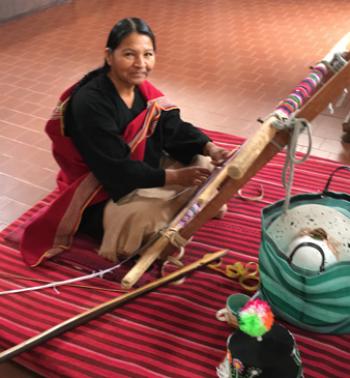Making the most of a Bolivia visit
This item appears on page 18 of the May 2020 issue.
After dreaming about a visit for many years, on June 24, 2019, I boarded Avianca for Bolivia, a landlocked republic that is home to the soaring Andes, South America’s largest lake (Titicaca) and the world’s largest salt flat (Salar de Uyuni). Its territory even includes part of the Amazon rainforest. Bolivia was once part of the Incan Empire, which stretched from Colombia to Argentina.
During my 3-week visit, I would take an 11-day group tour that I had booked through the Global Exploration for Educators Organization, or GEEO (700 E. Main St., Ste. 100, Norristown, PA 19401; 877/600-0105, https://geeo.org). The tour, “Bolivia Discovery,” was done in partnership with G Adventures (www.gadventures.com).
With any tour, my habit is to arrive at the point of departure four to seven days ahead of time and remain in the country anywhere from three to six days after the organized tour ends. I do this because I really love the sense of being independent before and after a tour. It’s also not unusual for me to strike out on my own during an organized tour rather than participate in every part of the scheduled itinerary.
The total cost of this amazing trip was less than $2,600, which included airfare, the GEEO tour, day tours, extra hotel nights and other incidentals. The 11-day group tour itself cost $1,536, including a single supplement (though I shared a room on two occasions).
I arrived at La Paz International Airport early in the morning of June 25; it was a chilly night. I had hired a driver to take me to the hotel in La Paz where our group would spend their first and last nights.
When we arrived at Las Brisas Hotel (c. Illampu Nro. 742 [El Rosario], La Paz, Bolivia; phone [591 2] 2463646, www.lasbrisas-hotel.com [in Spanish only]), the doors were locked and the staff member on duty was fast asleep. After the driver roused him, I checked in and was taken to my room, which cost me $30 per night and had a great view.
In the morning, Raquel, at the front desk, recommended restaurants in town plus places to see and helped me arrange local tours.
On one day, I was picked up by a tour bus filled with guests from other hotels, primarily Australians (who I really enjoyed being with), to see nearby attractions, such as the 18th-century Basilica of San Francisco and Valle de la Luna. The group then splintered, and a guide and I went on Mi Teleférico, an aerial cable car system offering picturesque views of the city below. I found the aerial view of La Paz unforgettable and loved every minute of the ride.
In addition, on a couple of days before the tour, the person who would be the guide on our GEEO tour, Soledad Vivianna Tito Lopez, showed me some of the sights of La Paz, including the Mercado de las Brujas (Witches’ Market). She is an excellent guide.
The eight members of our GEEO tour group met in the evening of June 28, and the next day we caught a plane to the central Andes city of Sucre. Bolivia’s capital is beautiful and has a pleasant temperate or ocean-like climate year-round (reminding me of my native Santa Barbara, California).
Sucre offers a variety of places to see and explore, such as Casa de la Libertad, the Cretaceous Park (with its dinosaur tracks; I enjoyed this attraction) and the Museum of Indigenous Art.
Our group left Sucre for Potosí in a few 4x4 vehicles. Potosí is located in southwestern Bolivia and is one of the highest-elevation cities in the world. It is renowned for its huge silver mine called Cerro Rico.
My personal principles caused me to forgo the mine tour. It was difficult for me to reconcile a visit to a mine that, in the past, caused so much suffering and misery and the deaths of countless Africans and indigenous peoples, who were forced to work for little or no financial compensation. However, I accept that others may have a different perspective on visiting the mine.
While the others toured Cerro Rico, I took in two of Potosí’s major tourist attractions, one being the San Luis Potosí Cathedral, which offers a stunning view of the city from its vintage rooftop.
Another was the Mint of Potosí museum, where I signed up on the spot for one of their tours (BOB40 [near $6]), held at different intervals. Providing an opportunity to learn about the major role silver played in the area’s early history, the museum displayed the various technologies that were used to extract silver from mines. I found the museum tour and the exhibits to be emotionally provocative and thought-provoking.
From Potosí, we traveled by the same 4x4 vehicles to the so-called white desert, Salar de Uyuni. The salt flat sits about 12,000 feet above sea level and covers an area of 4,000 square miles.
During our stay in the city of Uyuni, we enjoyed the region’s colorful landscapes and its diverse terrain and topography, from volcanoes to lagoons, where bird lovers can see flamingos in all their splendor. We also had the chance to tour the area called the “train cemetery,” given that moniker because of the old abandoned trains found in the area.
Visiting the salt flat was one of the highlights of my Bolivian journey.
It was at night when we boarded a bus bound for La Paz, arriving several hours later in the early morning. Our tour ended there on July 8.
Ensconced again at Las Brisas for a few days, before leaving for home I joined another bus group for a day tour to the ruins of Tiwanaku (BOB120), having made the arrangements a week and a half earlier with Raquel’s help.
Located about an hour’s drive from La Paz, Tiwanaku is a city dating back to the 6th and 7th centuries AD. It has large monoliths and amazing sculptures. The ruins provide an excellent glimpse “back in time” of one of the earliest civilizations of pre-Columbian America. As a historian, I found the ruins to be absolutely fascinating.
I departed for home on July 12. My visit to Bolivia remains one of my favorite trips to Latin America.
FRANK STEWART
Goleta, CA

